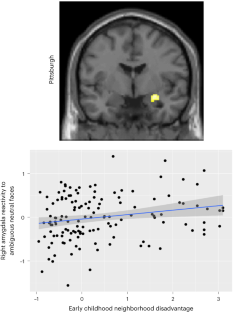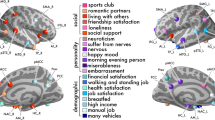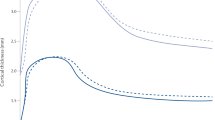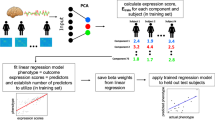Abstract
Consistent evidence documents powerful effects of social inequality on health, well-being and academic achievement. Yet research on whether social inequality may also be linked to brain structure and function has, until recently, been rare. Here we describe three methodological approaches that can be used to study this question—single site, single study; multi-site, single study; and spatial meta-analysis. We review empirical work that, using these approaches, has observed associations between neural outcomes and structural measures of social inequality—including structural stigma, community-level prejudice, gender inequality, neighbourhood disadvantage and the generosity of the social safety net for low-income families. We evaluate the relative strengths and limitations of these approaches, discuss ethical considerations and outline directions for future research. In doing so, we advocate for a paradigm shift in cognitive neuroscience that explicitly incorporates upstream structural and contextual factors, which we argue holds promise for uncovering the neural correlates of social inequality.
This is a preview of subscription content, access via your institution
Access options
Access Nature and 54 other Nature Portfolio journals
Get Nature+, our best-value online-access subscription
$29.99 / 30 days
cancel any time
Subscribe to this journal
Receive 12 digital issues and online access to articles
$119.00 per year
only $9.92 per issue
Buy this article
- Purchase on Springer Link
- Instant access to full article PDF
Prices may be subject to local taxes which are calculated during checkout



Similar content being viewed by others
References
Pickett, K. E., James, O. W. & Wilkinson, R. G. Income inequality and the prevalence of mental illness: a preliminary international analysis. J. Epidemiol. Community Health 60, 646–647 (2006).
Williams, D. R. & Collins, C. Racial residential segregation: a fundamental cause of racial disparities in health. Public Health Rep. 116, 404–416 (2001).
Mehra, R., Boyd, L. M. & Ickovics, J. R. Racial residential segregation and adverse birth outcomes: a systematic review and meta-analysis. Soc. Sci. Med. 191, 237–250 (2017).
McCoy, D. C., Raver, C. C. & Sharkey, P. Children’s cognitive performance and selective attention following recent community violence. J. Health Soc. Behav. 56, 19–36 (2015).
Sharkey, P., Schwartz, A. E., Ellen, I. G. & Lacoe, J. High stakes in the classroom, high stakes on the street: the effects of community violence on students’ standardized test performance. Sociol. Sci. 1, 199–220 (2014).
Evans-Lacko, S., Brohan, E., Mojtabai, R. & Thornicroft, G. Association between public views of mental illness and self-stigma among individuals with mental illness in 14 European countries. Psychol. Med. 42, 1741–1752 (2012).
Chae, D. H. et al. Association between an Internet-based measure of area racism and Black mortality. PLoS ONE 10, e0122963 (2015).
Chae, D. H. et al. Area racism and birth outcomes among Blacks in the United States. Soc. Sci. Med 199, 49–55 (2018).
Miller, C. T., Grover, K. W., Bunn, J. Y. & Solomon, S. E. Community norms about suppression of AIDS-related prejudice and perceptions of stigma by people with HIV or AIDS. Psychol. Sci. 22, 579–583 (2011).
Miller, C. T., Varni, S. E., Solomon, S. E., DeSarno, M. J. & Bunn, J. Y. Macro-level implicit HIV prejudice and the health of community residents with HIV. Health Psychol. 35, 807–815 (2016).
Perales, F. & Todd, A. Structural stigma and the health and wellbeing of Australian LGB populations: exploiting geographic variation in the results of the 2017 same-sex marriage plebiscite. Soc. Sci. Med 208, 190–199 (2018).
Hatzenbuehler, M. L., Flores, A. R. & Gates, G. J. Social attitudes regarding same‐sex marriage and LGBT health disparities: results from a national probability sample. J. Soc. Issues 73, 508–528 (2017).
Krieger, N. et al. Structural racism, historical redlining, and risk of preterm birth in New York City, 2013-2017. Am. J. Public Health https://doi.org/10.2105/AJPH.2020.305656 (2020).
Huo, Y. J., Dovidio, J. F., Jiménez, T. R. & Schildkraut, D. J. Local policy proposals can bridge Latino and (most) white Americans’ response to immigration. Proc. Natl Acad. Sci. USA 115, 945–950 (2018).
Hatzenbuehler, M. L. et al. Immigration policies and mental health morbidity among Latinos: A state-level analysis. Soc. Sci. Med 174, 169–178 (2017).
Samari, G., Catalano, R., Alcalá, H. E. & Gemmill, A. The Muslim Ban and preterm birth: analysis of US vital statistics data from 2009 to 2018. Soc. Sci. Med 265, 113544 (2020).
Hatzenbuehler, M. L., Keyes, K. M. & Hasin, D. S. State-level policies and psychiatric morbidity in lesbian, gay, and bisexual populations. Am. J. Public Health 99, 2275–2281 (2009).
Hatzenbuehler, M. L., McLaughlin, K. A., Keyes, K. M. & Hasin, D. S. The impact of institutional discrimination on psychiatric disorders in lesbian, gay, and bisexual populations: a prospective study. Am. J. Public Health 100, 452–459 (2010).
Hatzenbuehler, M. L. et al. Effect of same-sex marriage laws on health care use and expenditures in sexual minority men: a quasi-natural experiment. Am. J. Public Health 102, 285–291 (2012).
Raifman, J., Moscoe, E., Austin, S. B. & McConnell, M. Difference-in-differences analysis of the association between state same-sex marriage policies and adolescent suicide attempts. JAMA Pediatr. 171, 350–356 (2017).
Raifman, J., Moscoe, E., Austin, B., Hatzenhuehler, M. L. & Galea, S. Association of state laws permitting denial of services to same-sex couples with mental distress in sexual minority adults a difference-in-difference-in-differences analysis. JAMA Psych. 75, 671–677 (2018).
Levy, B. L. & Levy, D. L. When love meets hate: the relationship between state policies on gay and lesbian rights and hate crime incidence. Soc. Sci. Res 61, 142–159 (2017).
Everett, B. G., Hatzenbuehler, M. L. & Hughes, T. L. The impact of civil union legislation on minority stress, depression, and hazardous drinking in a diverse sample of sexual-minority women: a quasi-natural experiment. Soc. Sci. Med. 169, 180–190 (2016).
Blosnich, J. R. et al. Religious freedom restoration acts and sexual minority population health in the United States. Am. J. Orthopsychiatry https://doi.org/10.1037/ort0000349 (2018).
Leitner, J. B., Hehman, E., Ayduk, O. & Mendoza-Denton, R. Racial bias is associated with ingroup death rate for Blacks and whites: insights from Project Implicit. Soc. Sci. Med. 170, 220–227 (2016).
Morey, B. N., Gee, G. C., Muennig, P. & Hatzenbuehler, M. L. Community-level prejudice and mortality among immigrant groups. Soc. Sci. Med. 199, 56–66 (2018).
Sharkey, P. The acute effect of local homicides on children’s cognitive performance. Proc. Natl Acad. Sci. USA 107, 11733–11738 (2010).
Patel, V. et al. Income inequality and depression: a systematic review and meta-analysis of the association and a scoping review of mechanisms. World Psychiatry 17, 76–89 (2018).
Leitner, J. B., Hehman, E., Ayduk, O. & Mendoza-Denton, R. Blacks’ death rate due to circulatory diseases is positively related to whites’ explicit racial bias: A nationwide investigation using project implicit. Psychol. Sci. 27, 1299–1311 (2016).
Lukachko, A., Hatzenbuehler, M. L. & Keyes, K. M. Structural racism and myocardial infarction in the United States. Soc. Sci. Med. 103, 42–50 (2014).
Pearce, N. Epidemiology in a changing world: variation, causation and ubiquitous risk factors. Int J. Epidemiol. 40, 503–512 (2011).
Paus, T. Population neuroscience: why and how. Hum. Brain Mapp. 31, 891–903 (2010).
Falk, E. B. et al. What is a representative brain? Neuroscience meets population science. Proc. Natl Acad. Sci. USA 110, 17615–17622 (2013).
Suter, C. in Encyclopedia of Quality of Life and Well-Being Research (ed. Michalos, A. C.) 6093–6097 (2020).
Link, B. G. & Phelan, J. C. Conceptualizing stigma. Annu. Rev. Sociol. 27, 363–385 (2001).
Hatzenbuehler, M. L. Structural stigma: research evidence and implications for psychological science. Am. Psychologist 71, 742–751 (2016).
Levy, B. Stereotype embodiment: a psychosocial approach to aging. Curr. Dir. Psychol. Sci. 18, 332–336 (2009).
Pachankis, J. E. The psychological implications of concealing a stigma: a cognitive-affective-behavioral model. Psychol. Bull. 133, 328–345 (2007).
Pager, D. The mark of a criminal record. Am. J. Sociol. 108, 937–975 (2003).
Galobardes, B., Lynch, J. & Smith, G. D. Measuring socioeconomic position in health research. Br. Med. Bull. 81, 21–37 (2007).
Krieger, N., Williams, D. R. & Moss, N. E. Measuring social class in US public health research: concepts, methodologies and guidelines. Am. J. Public Health 18, 341–378 (1997).
Rehkopf, D. H. et al. Monitoring socioeconomic disparities in death: comparing individual-level education and area-based socioeconomic measures. Am. J. Public Health 96, 2135–2138 (2006).
Lattanner, M. R. et al. A contextual approach to the psychological study of identity concealment: examining direct, interactive, and indirect effects of structural stigma on concealment motivation across proximal and distal geographic levels. Psychol. Sci. 32, 1684–1696 (2021).
Tilcsik, A. Pride and prejudice: employment discrimination against openly gay men in the United States. Am. J. Sociol. 117, 586–626 (2011).
Hastings, P. D., Guyer, A. E. & Parra, L. A. Conceptualizing the influence of social and structural determinants of neurobiology and mental health: why and how biological psychiatry can do better at addressing the consequences of inequity. Biol. Psychiatry Cogn. Neurosci. Neuroimaging 7, 1215–1224 (2022).
Lewinn, K. Z., Sheridan, M. A., Keyes, K. M., Hamilton, A. & McLaughlin, K. A. Sample composition alters associations between age and brain structure. Nat. Commun. 8, 874 (2017).
Hyde, L. W. et al. An ecological approach to understanding the developing brain: examples linking poverty, parenting, neighborhoods, and the brain. Am. Psychologist 75, 1245–1259 (2020).
Gard, A. M. et al. Beyond family-level adversities: exploring the developmental timing of neighborhood disadvantage effects on the brain. Dev. Sci. 24, e12985 (2021).
Hatzenbuehler, M. L. et al. Smaller hippocampal volume among black and latinx youth living in high-stigma contexts. J. Am. Acad. Child Adolesc. Psychiatry 61, 809–819 (2022).
Walhovd, K. B. et al. Education and income show heterogeneous relationships to lifespan brain and cognitive differences across European and US cohorts. Cereb. Cortex 32, 839–854 (2022).
Adler, N. E. & Newman, K. Socioeconomic disparities in health: pathways and policies. Health Aff. 21, 60–76 (2002).
Adler, N. E. & Rehkopf, D. H. U.S. disparities in health: Descriptions, causes, and mechanisms. Annu. Rev. Pub. Health 29, 235–252 (2008).
Schmader, T. & Johns, M. Converging evidence that stereotype threat reduces working memory capacity. J. Pers. Soc. Psychol. 85, 440–452 (2003).
Macintyre, S., Maciver, S. & Sooman, A. Area, class and health: should we be focusing on places or people? J. Soc. Policy 22, e053 (1993).
Whiteis, D. G. Hospital and community characteristics in closures of urban hospitals, 1980-87. Public Health Rep. 107, 409–416 (1992).
Eisenberger, N. I., Lieberman, M. D. & Williams, K. D. Does rejection hurt? An fMRI study of social exclusion. Science 302, 290–292 (2003).
McLaughlin, K. A., Weissman, D. & Bitrán, D. Childhood adversity and neural development: a systematic review. Annu Rev. Dev. Psychol. 1, 277–312 (2019).
Amodio, D. M. & Cikara, M. The social neuroscience of prejudice. Annu Rev. Psychol. 72, 439–469 (2021).
Hein, T. C. & Monk, C. S. Research review: neural response to threat in children, adolescents, and adults after child maltreatment – a quantitative meta-analysis. J. Child Psychol. Psychiatry 58, 222–230 (2017).
Noble, K. G. et al. Family income, parental education and brain structure in children and adolescents. Nat. Neurosci. 18, 773–778 (2015).
Luby, J. et al. The effects of poverty on childhood brain development: the mediating effect of caregiving and stressful life events. JAMA Pediatr. 167, 1135–1142 (2013).
Gilmore, R. O., Diaz, M. T., Wyble, B. A. & Yarkoni, T. Progress toward openness, transparency, and reproducibility in cognitive neuroscience. Ann. NY Acad. Sci. 1396, 5–18 (2017).
Klapwijk, E. T., van den Bos, W., Tamnes, C. K., Raschle, N. M. & Mills, K. L. Opportunities for increased reproducibility and replicability of developmental neuroimaging. Dev. Cogn. Neurosci. 47, 100902 (2021).
Poldrack, R. A. et al. Scanning the horizon: towards transparent and reproducible neuroimaging research. Nat. Rev. Neurosci. 18, 115–126 (2017).
Van Bavel, J. J., Mende-Siedlecki, P., Brady, W. J. & Reinero, D. A. Contextual sensitivity in scientific reproducibility. Proc. Natl Acad. Sci. USA 113, 6454–6459 (2016).
Casey, B. J., Taylor-Thompson, K., Rubien-Thomas, E., Robbins, M. & Baskin-Sommers, A. Healthy development as a human right: Insights from developmental neuroscience for youth justice. Annu Rev Law Soc Sci 16, 203–222 (2020).
Tomlinson, R. C. et al. Neighborhood poverty predicts altered neural and behavioral response inhibition. Neuroimage 209, 116536 (2020).
Tooley, U. A. et al. Associations between neighborhood SES and functional brain network development. Cereb. Cortex 30, 1–19 (2020).
Krishnadas, R. et al. Socioeconomic deprivation and cortical morphology: psychological, social, and biological determinants of ill health study. Psychosom Med 75, 616–623 (2013).
Ramphal, B. et al. Brain connectivity and socioeconomic status at birth and externalizing symptoms at age 2 years. Dev. Cogn. Neurosci. 45, 100811 (2020).
Murtha, K. et al. Associations between neighborhood socioeconomic status, parental education, and executive system activation in youth. Cereb. Cortex 33, 1058–1073 (2023).
Hannan, E. L., Wu, Y., Cozzens, K. & Anderson, B. The Neighborhood Atlas Area Deprivation Index for measuring socioeconomic status: an overemphasis on home value. Health Aff. 42, 702–709 (2023).
Trinidad, S. et al. Use of area-based socioeconomic deprivation indices: a scoping review and qualitative analysis. Health Aff. 41, 1804–1811 (2022).
Leventhal, T. & Brooks-Gunn, J. The neighborhoods they live in: the effects of neighborhood residence on child and adolescent outcomes. Psychol. Bull. 126, 309–37 (2000).
Jenkins, L. M. et al. Subcortical structural variations associated with low socioeconomic status in adolescents. Hum. Brain Mapp. 41, 162–171 (2020).
Al Hazzouri, A. Z. et al. Racial residential segregation in young adulthood and brain integrity in middle age: can we learn from small samples? Am. J. Epidemiol. 191, 591–598 (2022).
Harnett, N. G. et al. Structural inequities contribute to racial/ethnic differences in neurophysiological tone, but not threat reactivity, after trauma exposure. Mol. Psychiatry 28, 2975–2984 (2023).
Weissman, D. G., Hatzenbuehler, M. L., Cikara, M., Barch, D. M. & McLaughlin, K. A. State-level macro-economic factors moderate the association of low income with brain structure and mental health in U.S. children. Nat. Commun. 14, 2085 (2023).
Hanson, J. L., Chandra, A., Wolfe, B. L. & Pollak, S. D. Association between income and the hippocampus. PLoS ONE 6, e18712 (2011).
Decker, A. L., Duncan, K., Finn, A. S. & Mabbott, D. J. Children’s family income is associated with cognitive function and volume of anterior not posterior hippocampus. Nat Commun 11, 4040 (2020).
Fan, C. C. et al. Adolescent Brain Cognitive Development (ABCD) study linked external data (LED): protocol and practices for geocoding and assignment of environmental data. Dev. Cogn. Neurosci. 52, 101030 (2021).
Johnson, B. T., Cromley, E. K. & Marrouch, N. Spatiotemporal meta-analysis: reviewing health psychology phenomena over space and time. Health Psychol. Rev. 11, 280–291 (2017).
Hatzenbuehler, M. L., Mclaughlin, K. A., Weissman, D. G. & Cikara, M. Community-level explicit racial prejudice potentiates whites’ neural responses to black faces: a spatial meta-analysis. Soc. Neurosci. 17, 508–519 (2022).
Gaye, A., Klugman, J., Kovacevic, M., Twigg, S. & Zambrano, E. Measuring Key Disparities in Human Development: the Gender Inequality Index. Human Development Research Paper (United Nations Development Programme, 2010).
Crotti, R., Pal, K. K., Ratcheva, V. & Zahidi, S. The Global Gender Gap Report 2021 (World Economic Forum, 2021).
Zugman, A. et al. Country-level gender inequality is associated with structural differences in the brains of women and men. Proc. Natl Acad. Sci. USA 120, e2218782120 (2023).
Kober, H. & Wager, T. D. Meta-analysis of neuroimaging data. Wiley Interdiscip. Rev. Cogn. Sci. 1, 293–300 (2010).
Lindquist, K. A., Satpute, A. B., Wager, T. D., Weber, J. & Barrett, L. F. The brain basis of positive and negative affect: evidence from a meta-analysis of the human neuroimaging literature. Cereb. Cortex 26, 1910–1922 (2016).
Murty, V. P., Ritchey, M., Adcock, R. A. & LaBar, K. S. Reprint of: fMRI studies of successful emotional memory encoding: a quantitative meta-analysis. Neuropsychologia 49, 695–705 (2011).
Turner, B. O., Paul, E. J., Miller, M. B. & Barbey, A. K. Small sample sizes reduce the replicability of task-based fMRI studies. Commun. Biol. 1, 62 (2018).
Wager, T. D., Lindquist, M. & Kaplan, L. Meta-analysis of functional neuroimaging data: current and future directions. Soc. Cogn. Affect Neurosci. 2, 150–158 (2007).
Lindquist, K. A., Wager, T. D., Kober, H., Bliss-Moreau, E. & Barrett, L. F. The brain basis of emotion: a meta-analytic review. Behav. Brain Sci. 35, 121–143 (2012).
Cremers, H. R., Wager, T. D. & Yarkoni, T. The relation between statistical power and inference in fMRI. PLoS ONE 12, e0184923 (2017).
Parker, R. & Aggleton, P. HIV and AIDS-related stigma and discrimination: a conceptual framework and implications for action. Soc. Sci. Med 57, 13–24 (2003).
Hatzenbuehler, M. L., Phelan, J. C. & Link, B. G. Stigma as a fundamental cause of population health inequalities. Am. J. Public Health 103, 813–821 (2013).
Hardeman, R. R., Homan, P. A., Chantarat, T., Davis, B. A. & Brown, T. H. Improving the measurement of structural racism to achieve antiracist health policy. Health Aff. 41, 179–186 (2022).
Cikara, M., Fouka, V. & Tabellini, M. Hate crime towards minoritized groups increases as they increase in sized-based rank. Nat. Hum. Behav. 6, 1544–1544 (2022).
Garcini, L. M. et al. Increasing diversity in developmental cognitive neuroscience: a roadmap for increasing representation in pediatric neuroimaging research. Dev. Cogn. Neurosci. 58, 101167 (2022).
Keyes, K. M. et al. What is not measured cannot be counted: sample characteristics reported in studies of hippocampal volume and depression in neuroimaging studies. Biol. Psychiatry Cogn. Neurosci. Neuroimaging 8, 492–494 (2023).
Sampson, R. J. Moving to inequality: neighborhood effects and experiments meet social structure. Am. J. Sociol. 114, 189–231 (2008).
Poldrack, R. A. Inferring mental states from neuroimaging data: from reverse inference to large-scale decoding. Neuron 72, 692–697 (2011).
Lipsitch, M., Tchetgen Tchetgen, E. & Cohen, T. Negative controls: a tool for detecting confounding and bias in observational studies. Epidemiology 21, 383–388 (2010).
Ricard, J. A. et al. Confronting racially exclusionary practices in the acquisition and analyses of neuroimaging data. Nat. Neurosci. 26, 4–11 (2023).
White, E. J. et al. Five recommendations for using large-scale publicly available data to advance health among American Indian peoples: the Adolescent Brain and Cognitive Development (ABCD) StudySM as an illustrative case. Neuropsychopharmacology 48, 263–269 (2023).
Cook, T. D., Campbell, D. T. & Shadish, W. Experimental and Quasi-Experimental Designs for Generalized Causal Inference (Houghton Mifflin, 2002).
Hatzenbuehler, M. L. Advancing research on structural stigma and sexual orientation disparities in mental health among youth. J. Clin. Child Adolesc. Psychol. 46, 463–475 (2017).
Chetty, R. & Hendren, N. The impacts of neighborhoods on intergenerational mobility I: childhood exposure effects. Q. J. Econ. 133, 1107–1162 (2017).
Sukumaran, K. et al. Ambient fine particulate exposure and subcortical gray matter microarchitecture in 9- and 10-year-old children across the United States. iScience 26, 106087 (2023).
Berman, M. G., Stier, A. J. & Akcelik, G. N. Environmental neuroscience. Am. Psychologist 74, 1039–1052 (2019).
Williams, D. R., Yu, Y., Jackson, J. S. & Anderson, N. B. Racial differences in physical and mental health: socio-economic status, stress and discrimination. J. Health Psychol. 2, 335–351 (1997).
Frost, D. M. et al. Couple-level minority stress: an examination of same-sex couples’ unique experiences. J. Health Soc. Behav. 58, 455–472 (2017).
Hewstone, M., Rubin, M. & Willis, H. Intergroup bias. Annu Rev. Psychol. 53, 575–604 (2002).
Reid, A. E., Dovidio, J. F., Ballester, E. & Johnson, B. T. HIV prevention interventions to reduce sexual risk for African Americans: the influence of community-level stigma and psychological processes. Soc. Sci. Med 103, 118–125 (2014).
Payne, B. K., Vuletich, H. A. & Brown-Iannuzzi, J. L. Historical roots of implicit bias in slavery. Proc. Natl Acad. Sci. USA 116, 11693–11698 (2019).
Hatzenbuehler, M. L. et al. Trends in state policy support for sexual minorities and HIV-related outcomes among men who have sex with men in the United States, 2008–2014. J. Acquir. Immune Defic. Syndr. 85, 39–45 (2020).
Krieger, N., Chen, J. T., Coull, B., Waterman, P. D. & Beckfield, J. The unique impact of abolition of Jim Crow laws on reducing inequities in infant death rates and implications for choice of comparison groups in analyzing societal determinants of health. Am. J. Public Health 103, 2234–2244 (2013).
Burris, S. et al. Making the case for laws that improve health: a framework for public health law research. Milbank Q. 88, 169–210 (2010).
Flores, A. R., Hatzenbuehler, M. L. & Gates, G. J. Identifying psychological responses of stigmatized groups to referendums. Proc. Natl Acad. Sci. USA 115, 3816–3821 (2018).
Author information
Authors and Affiliations
Corresponding author
Ethics declarations
Competing interests
The authors declare no competing interests.
Peer review
Peer review information
Nature Human Behaviour thanks Carlos Cardenas-Iniguez, and the other, anonymous, reviewer(s) for their contribution to the peer review of this work.
Additional information
Publisher’s note Springer Nature remains neutral with regard to jurisdictional claims in published maps and institutional affiliations.
Rights and permissions
Springer Nature or its licensor (e.g. a society or other partner) holds exclusive rights to this article under a publishing agreement with the author(s) or other rightsholder(s); author self-archiving of the accepted manuscript version of this article is solely governed by the terms of such publishing agreement and applicable law.
About this article
Cite this article
Hatzenbuehler, M.L., McLaughlin, K.A., Weissman, D.G. et al. A research agenda for understanding how social inequality is linked to brain structure and function. Nat Hum Behav 8, 20–31 (2024). https://doi.org/10.1038/s41562-023-01774-8
Received:
Accepted:
Published:
Issue Date:
DOI: https://doi.org/10.1038/s41562-023-01774-8



